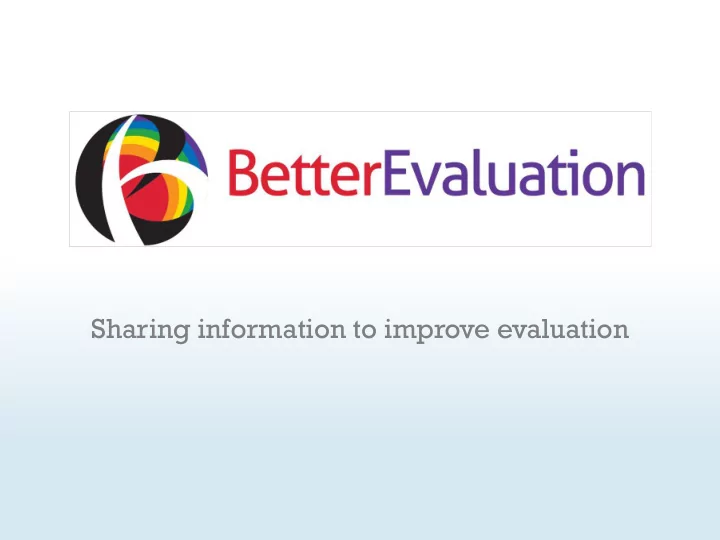

Sharing information to improve evaluation
Choosing evaluation methods to suit the complex ecologies of the particular intervention and evaluation How the BetterEvaluation platform can support appropriate evaluation design Patricia Rogers - RMIT Simon Hearn - ODI American Evaluation Association Conference 25 October 2012, Minneapolis, MN
BetterEvaluation 1. Challenges and opportunities 2. Harnessing the power of we 3. Demonstration scenarios – choosing methods and using them well 4. Building knowledge about evaluation that suits complex ecologies
Challenges It is hard to choose the right combination of evaluation methods It is hard to know how to implement them well
Opportunities Lots of existing material on evaluation methods (some not maintained) Many people willing to share their experience and expertise
Founding Partners Financial Supporters
Documenting Sharing R & D Events Descriptions Comments Examples Guides Tools
Co-creation by practitioners, researchers, sector experts, method experts
Reflection, processes for quality and authenticity
Rooted in practical experience
Advice from experienced practitioners
Task oriented taxonomy: Support to navigate options Photo: David Masters
FRAMEWORK Over 200 methods/options related to 35 tasks in 7 clusters
Methods/Options that address all aspects of evaluation MANAGE REPORT & SUPPORT DEFINE USE SYNTHESIZE & FRAME VALUE UNDERSTAND DESCRIBE CAUSES 15 CDC Evaluation Framework with BetterEvaluation components overlaid 15
Methodological pluralism Simon Kneebone ‘ Show Me The Change ” http://www.flickr.com/photos/smtc/sets/72157624112171834/
Spotlight on invisible evaluation tasks and less well known methods 18
Respectful, inclusive and constructive discussion 19
• Proof of concept and closed beta phase 2011-2012 • Now live (October 2012) and in open beta phase • Formal launch in 2013
Content • Nearly 200 options pages • Over 500 resource pages • 16 approaches (package of methods) • 8 thematic pages – sectors or cross-cutting issues
Choose the right method Information on methods : Description • Examples • Advice for choosing the method • Advice for using the method • Short list of recommended • resources A full list of all resources, ordered • by user rating This information helps users • determine if the method suits their needs and requirements
Scenario 1- describing a situation • Community renewal project • Have existing social indicator profile • Want to learn how the residents see their community – what are its strengths and problems? • Intended users of the evaluation – local Council for planning and advocacy • What methods might you use? • Under what circumstances might you use them?
Information from individuals • Deliberative Opinion • Logs and Diaries Polls • Mobile Phone Logging • Email Questionnaires : • Peer/Expert Reviews • Face to Face • Photolanguage Questionnaires • Postcards • Global Assessment • Projective Techniques Scales • Questionnaires • Goal Attainment • Seasonal Calendars Scales (GAS) • Sketch Mapping • Internet Questionnaires • Stories (Anecdote) • Interviews • Telephone Questionnaires • Key Informant
Information from groups • After Action • Focus Groups Review • Future Search • Brainstorming Conference • Card Visualization: • Hierarchical Card Sorting • Concept Mapping • Keypad technology • Convergent Interviewing • Mural • Delphi Study • ORID • Dotmocracy • SWOT Analysis • Fishbowl • World Cafe Technique
Scenario 1- methods to collect data • Which methods were suggested by the group? • Which methods were not suggested? • What new methods sound potentially useful? • What information would you need to be able to use (or oversee someone using) a new method?
Scenario 1- PhotoVoice Participatory photography method Particularly useful for giving a voice to marginalized people Community members : • Take photos • Select the most significant photos • Tell stories about what they mean • Identify key themes What questions would you ask?
• What would you need to know in order to appropriately choose and use PhotoVoice? • What questions would you ask of someone who had used it?
Some insights from an evaluation practitioner • Lynne Man - User of PhotoVoice AEA 2012 Poster 109 Through the Eyes of Older Adults: Using PhotoVoice to Understand Volunteers
Scenario 2- causal inference • Completed health intervention to reduce early childhood obesity • Series of evening information sessions • Ten participating families • Data (from service records) show children’s weight was high at the beginning and lower afterwards • Intended users – management of health service to inform decision about future funding • What methods might you use? • Under what circumstances might you use them?
Source: Hick, P. (1988) An Evaluation of a Nutrition Program for Young Turkish Mothers. Unpublished paper for the Graduate Diploma in Adult and Continuing Education, Melbourne College of Advanced Education. Presented as a case study in Owen, J. (1999) Program Evaluation: Forms and Approaches (2 nd edition). Sydney: Allen & Unwin
Weights of subsequent children Source: Hick, P. (1988) An Evaluation of a Nutrition Program for Young Turkish Mothers. Unpublished paper for the Graduate Diploma in Adult and Continuing Education, Melbourne College of Advanced Education. Presented as a case study in Owen, J. (1999) Program Evaluation: Forms and Approaches (2 nd edition). Sydney: Allen & Unwin
Scenario 2 - Check timing is consistent with program theory • Use time series data to go beyond just ‘Before’ & ‘After’ • See if the change trajectory is consistent with the theory that the program has caused the observed results
Scenario 2 - General Elimination Method • Identify possible alternative explanations • Gather and analyze data to see if these can be ruled out
Scenario 2 - methods for causal inference • Which methods were suggested by the group? • Which methods were not suggested? • What new methods sound potentially useful? • What information would you need to be able to use (or oversee someone using) a new method?
How could you contribute to BetterEvaluation? Suggest Comment Improve the methods on content description Suggest Rate Curate a resources resources section Host an Share Spread the event experiences word
patricia.rogers@rmit.edu.au s.hearn@odi.org.uk betterevaluation.org
Recommend
More recommend